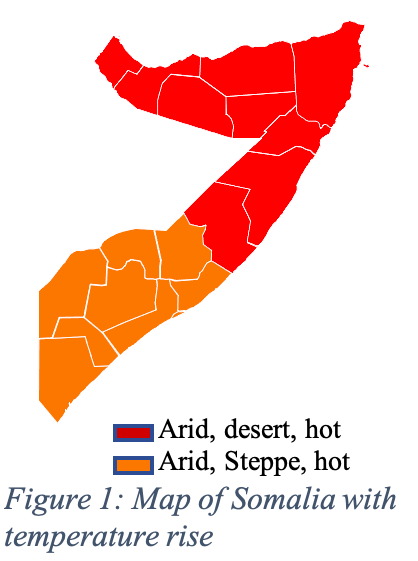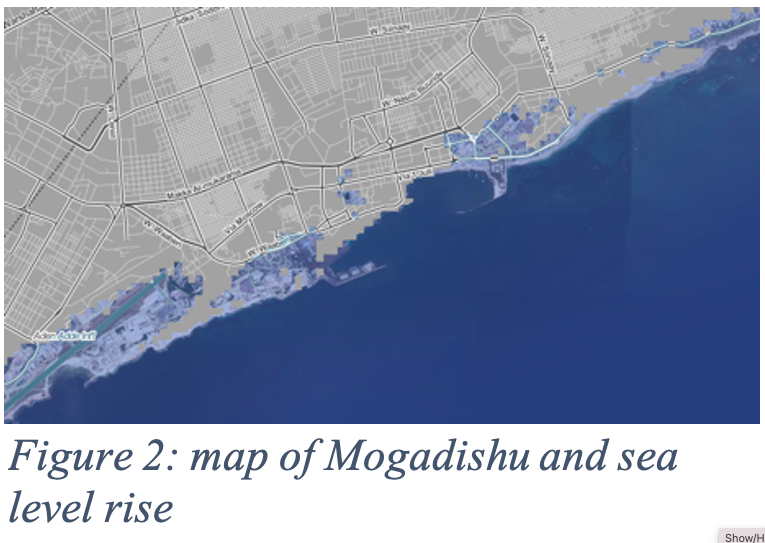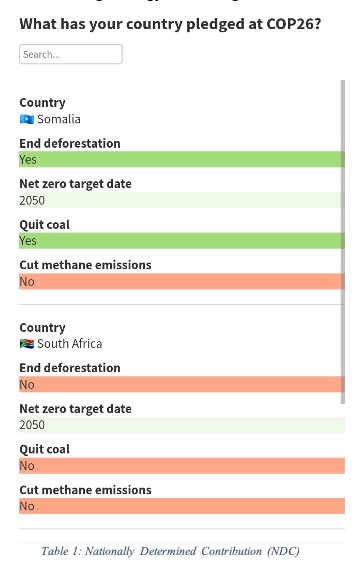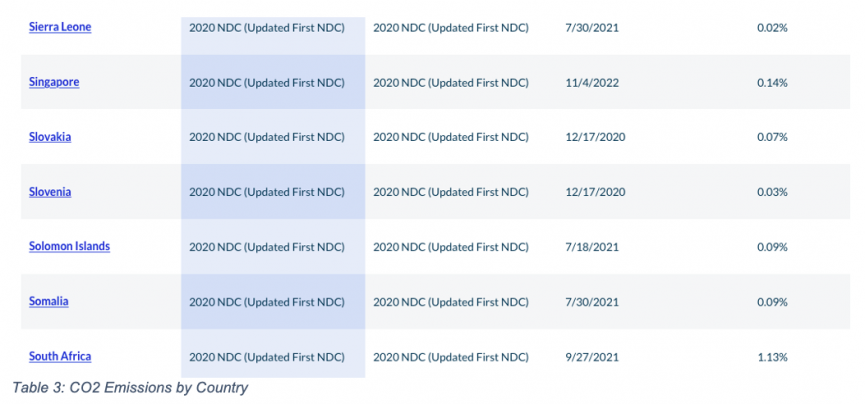
Impact of climate change in Somalia

Somalia is among the
most vulnerable countries to the effect of the climate change and its impact
will be devastating to say the least. As the livelihood of more than 50% of the
population depends of livestock animals, the impact of climate change will be
in full display in the coming 20 years. Temperatures will rise by 20C with
unpredictable successive droughts and floods. This also means a large portion
of the country may become uninhabitable as a result of the rapid effects of
climate change, which would have disastrous effects on human health and food
security as shown in figure1.
One positive thing for Somalia is the impact of sea level rise as most of the cities in country is at least 410m higher than the sea level. By the year 2100, you will be able to swim near K4. Aden Adde Airport and the sea port will both be fully submerged and so will be most of the Waberi, Hamar Weyne, Shingani and Bodhere districts. Ali Madi Hotel will be the part of the Leedo beach, as shown in figure 2.
For many nations including many in the pacific islands of just 1m above the sea level, some will become partially or fully submerged.
Scientists have predicted that unless we keep the temperature to 1.5 0C by 2050, we will reach a point of no return and as we are failing to reduce emissions it seems that most of living beings will be doomed to extinction. The year 2050 is fast approaching while the world is playing a blaming game.

The West claims they
have reduced emissions and are reaching their net-zero emission targets. They
also claim that developing nations such as China and India are currently
emitting more greenhouse gasses. That is true, but if you look population wise,
Western nations emit 3 times more per capita than India. It’s also worth
mentioning that the European nations have moved their high energy-consuming
industries to Asian some countries, thus increasing global emissions in addition
to their efforts of transporting goods back and forth to the West.
As successful COPs failed to deliver the agreements required to limit emissions to 1.50C, the COP 27 in Sharma-el-Sheikh become yet another disappointing meeting even though rich nations vaguely agreed to pay rebate. The poor nations are negotiating with the rich bilaterally to help them mitigate or adopt to the climate change, while the developing nations keep refusing to cut carbon emissions as their countries need to further develop and put the blame on the west while emitting 90% of the greenhouse gases and still continue to pollute the atmosphere.
1. What is the Somali Government doing to mitigate the climate change?
The answer is simple, ‘Absolutely Nothing’. The team from Somalia the Sharm-el-Sheikh summit were simply high-profile selected members who were ill prepared and uninterested of what was at stake as the relevant technocrats and experts in the issue of discussion were left behind in Somalia. In contrast, the Kenyan government hand-picked a highly qualified team of scientists, engineers, agronomists, environmental and energy experts and any other sector which may be affected by the climate change the day after COP26 in Glasgow.
Kenya came up with bankable projects and negotiated bilateral agreements with every nation, while Somalia on the other hand had nothing to negotiate with. But instead, Somalia has confined itself with the blindly signing the Nationally Determined Contributions (NDC) in COP26 as shown in table 1 bellow.
Almost 50% of the rich nations did not yet sign to phase out the use of coal or agreed to become net-zero by 2050. Unfortunately, the Somalia Ministry of energy signed to reduce the emissions as part of the country’s NDC. As you can see even in this small section shown here, Somalia signed more than any other nation.
Let us have a look at what we have signed for means:
1. Stop deforestation.
98% of the energy we use in Somalia for lighting and cooking is in the form of firewood and charcoal. To stop deforestation, we need afforestation project in line with the number of trees we cut or clean cooking means as well as other renewable energy for lighting. I don’t think the government of Somalia can undertake and finance such large-scale projects costing more than half a billion USD. One other way of stopping deforestation would be to stop cooking and probably eat raw meat.
2. Net-Zero carbon by 2050.
To have net-zero carbon means to have renewable energy for electricity generation and electrical cars and tricycle bikes in all major cities in Somalia. As the WB’s infamous Somali Electricity Access Project (SEAP) delivered solar PV systems of 10 W to 100 households, the task of electrifying the nation with renewable energy falls to the Government and ESPs.
3. Phase out coal
I am personally an environmentalist and against the use of coal, but if some of the western nations didn’t stop the use of coal for electricity generation and China and India are actually increasing the use of coal, why will Somalia have to stop specially with high quality of coal resources which have never been used? There is enough coal in Adale district in the south and much more in Somaliland which can be used before the middle of the century to help the country build its economy.
4. Cut methane emissions
The majority of methine emissions come from leakages of gas pipelines and chemical processing industries both of which we don’t have. Some methine emissions to the atmosphere come also from cow farming as well as rice paddies. Again, we don’t cultivate rice and the number of cows in Somalia have been shrinking in the last 25 years. What I don’t understand here, is why do we have to refuse to cut methane-which we don’t need, and accept to stop using charcoal- which we need?
What is more surprising is that Somalia have submitted their greenhouse gas contribution as you can see in the table 2 bellow.

What is surprising is
that Somalia produces more greenhouse gasses than some EU countries and almost
the same as South Africa as shown in the table above. The same Somali that
according to WB and AfDB reports, who are only 11% electricity access. Is this
being double edge sword or simple stupid mistake? How can we be the least
electrified nation and contribute more greenhouse gas than others? This data is
from UNFCC official website, but the question is who provided this data? For
sure, it is either the Somalia or the Ministry of energy or the WB energy
office for Somalia and I personally suspect it is the later.
And finally, as you can see from the table 3 below, Somalia have No national adaptation plan or at least have not submitted any unlike all the African nations.

2. What about the international community?
The answer again is absolutely nothing. In fact, the UN is contributing more to the world greenhouse gases than Somalia. The electricity consumption in the UN compound in Mogadishu is estimated to be 1,400kWh per person compared to 140kWh/person in the south-central Somalia which is 10 times more. this is because in the UN compound, there are 5-star hotels, offices, meeting halls, residential areas, swimming pools and so on. 2,000 to 3,000W air-conditioning units are installed in every duelling and are operational 24/7 even when they are not in use while 100W flood lights are installed every 30 meters. A quick look of the night sky in Mogadishu will give you the picture of what I am talking about. All this electrical energy is generated by burning fossil fuel.
Add to that about the 120 daily flights to every city in Somalia and off course to and from Nairobi without forgetting the number of vehicles travelling within the compound. This is why SKA (an international company) have offices in every major city in Somalia to supply fossil fuel to the UN and other international organisations in Somalia. I think the UN should have signed the NDC not the Somalians who according to the WB need only 10W electricity per household. Another UN contribution to the local climate is the amount of waste they generate with no disposal plan in place. They normally contract local companies for the waste disposal who in turn, just dump them to the ocean or simply burn it.
Antonio Gutters in his speech at COP27 in Sherm el Shiekh, he asked all countries to reduce emissions this decade in line with the 1.5-degree goal but he should also lead by example and start cleaning his house first.
3. The immediate impact of climate change in Somalia
Droughts in Somalia used to happen every 10 years before the civil war and every other year in most recently, combined with floods. In the near future, it is expected to see successive droughts and floods more and more frequently. The Somali economy, which is mainly based on livestock animals will crash and 45% of the population that depend of these livestock animals will either perish or relocate across the country. As water resources and grazing lands diminish year after year, tribal conflicts on these resources are expected to intensify in the north and central regions including Hirshabelle. In the end, a large migration from the north to south will take place and the population of Mogadishu will be in the quadruple at this rate.
In the south, farmers will also be affected considerably as crops fail year after the other. The migration from the south will mainly be in the form of IDP’s with more devastating death toll particularly in the Southwest state. In terms of livestock animal, cows will almost be extinct where as the number of sheep and goats will be greatly reduced. Camels are expected to adopt to the climate change. This means Puntland and Somaliland source of incomes will be greatly reduced as they depend on the livestock exportations despite having better governance system than the southcentral. The Sool and Sanag regions as well as the western parts of Somaliland will be affected mostly.
The extremist group in Somalia who control the rural areas in the Southcentral regions in Somalia will also feel the impact of the climate change more harshly as the migration and death toll will be twice more in the regions they control. That is if they survive the current offensive actions from the federal government.
4. Who will survive and/or benefit from the climate change impact?
It is human nature that some will always profit from the misfortunes of others. Those who will profit from the climate change impact include;
· Corrupt officials will make millions as the country will slide back into a humanitarian state, more of which will wreck millions in the Southcentral regions.
· Ruthless business practices that currently provide services such as communications and utilities.
· Remittance companies as the Somali diaspora are forced to send more and more money back home to their families.
· The mitigating measures of climate change for UAE are based on logistics and marine transport and their target is the strategic coast land of Somalia. They will control all of the four major ports in Somalia and this will give them control of the Indian Ocean and the Gulf of Adan. The UAE will phase a harsher environment than Somalia and as they are running out of oil (or oil will be phased out), they need another GDP based source of income.
· Aid agencies will also benefit as Somalia will become a charity hotspot where money is raised and concerts will be held yearly in Hyde park, London.
This is not fake news or my opinion for that matter. This is the most probable scenario based on the current activities and planes of both the Somalia government and international organisations and communities.
5. Required mitigation and adaptation measures
Now, I hope you don’t expect me to come up with a perfect plan to solve the climate impact in Somalia. Off course not. But let me guide you in the right direction and we have to know that there is no silver bullet here. What I am sure of is that, this is a Somali problem in need of a Somali solution. This needs group of experts in every field to cooperate and develop national climate change mitigation plan for Somalia.
Before summarising a possible action plan, I would like to point a few facts. When asked a UK expert about the impact of climate change in Somalia on the BBC Radio 4, he clearly stated that millions of lives will be lost in Somalia and worst of all, he said, and I quote "The country can NOT even absorb the kind of cash required”. This is partially true as time and time again, the Somali officials have stated their lack of capacity to govern.
Every minister in every sector, when asked about his or her priority, they will say capacity building. Is this as a result of the NGOs culture during the past 30 years? Or does the capacity building means an easy way of making a few dollars? I do not know. But what I remember is that David Cameron stated that Somalia has the best resources that many failed nations don’t, and he meant the millions of well-educated first generation British/Somalians, during London conference in 2014.
I understand too well that attracting well-educated Somalis in the diaspora from Europe and America is extremely difficult for the FGS, particularly if they are to work in the Southcentral regions. The government will not be able to pay their salary and security will be yet another issue. But how about the international organisations? They are paying over 100,000 USD per annum to less qualified internationals with no concept of the economic, cultural and political practices of the country. Furthermore, these experts are mainly based in Nairobi and would not even be able to conduct a simple assessment or feasibility study of the projects they are paid to design.
On the other hand, 600 billion USD was spent on what the WB Somalia called ‘Capacity injection for Somalia’. The question is, how much of the 600 billion is spent in Somalia, excluding the UN compound and the elite Somalis who run Hotels, restaurants and services in the compound? How about QUESTS/MIDA? A program run by the UNDP to attract Somalia experts to work in the country and funded by IOM? How much did this project achieve?
Unfortunately, Somalians have amnesia. They seem to forget what happened last year and the year before. And furthermore, they don’t believe they are capable of influencing what will happen tomorrow. I am not a psychologist, but I suspect that this is the result of more than 30 years of civil wars. Even the local experts are in coma as they have been excluded from the government positions and the international contracts.
Again, before my list of recommendations, let me inform you who will be in charge and receive funds whether we call rebate or damages for climate change mitigation and adaptation measures for Somalia.
· No fund will be available for the Federal Government of Somalia as per their own admission, they are incapable of managing such funds.
· No funds will also be given to any national profit or non-profit organisation either.
· As far as I know, and I don’t know as much as many Somali insiders; a large number of international organisations, international non-profit organisations and international profit organisations will receive billions of funds from rich countries to develop resilience projects for Somalia.
· As I am writing this report today, hundreds of millions have already been secured by the international organisations active in Somalia to help the country against the imminent climate change impacts and I don’t have to tell you the effectiveness of such projects and programs as we have seen them in the past years. Many more millions will go in the same direction unless the current international practices are changed.
Someone pointed out that, "I can’t teach new tricks to an old dog” after reading my last article and I absolutely agree with him. Unfortunately, old institutions such as WB, FIFA and UN tend to resist changes even in the face this dynamic and ever-changing world. WBG is indeed a very old dog and I have no intention to teach them anything, I am rather trying to teach some basic context of the country to the WB Energy office in Somalia. This is only four years old and even younger in dog years. If we can not teach anything to this young dog, we have to put him down.
I have been also accused of being against the WB in my last article and that is not true. The WBG have implemented excellent projects and programs in Somalia such as, the public finance management (PFM) and its FMIS for the Ministry of Finance. In the energy sector though, they seem to be developing projects that are designed to fail from start.
Does that mean we are all doomed? Not necessarily as my action points listed here bellow suggest, even though some of them are more challenging than others;
6. Recommendations
1. Recall both local and diaspora Somali experts in every field, at least for a short while and develop national mitigation measure plan. The current national plan useless and outdated. The country needs new clear concise an achievable plan with investment actions. This should be based entirely on the national climate change mitigation plan.
2. If such plan is ready before COP28, with amount of investment required and it’s implementation plan, the government will be in a position to demand funds due from the rich countries.
3. The government should develop the fishery sector (blue-economy) which can replace the livestock sector in terms of GDP.
4. New ways of livestock husbandry should be developed such as zero-grazing dairy farms and animal fattening businesses.
5. In the agriculture, as floods and droughts will be more frequent, new ways of farming such as drip irrigation and greenhouse farming should be developed.
6. The most important of all in climate change mitigation is good governance where funds are directed where it is needed the most. The government should fight corruption. The worst corruption is to keep the national experts at bay and instead distribute the key government positions which requires knowledge and expertise following the 4.5 federal tribal power-sharing system
7. Shabelle river water management project should be initiated to reduce flooding and water reaching downstream farmers.
8. Massive afforestation project should be initiated if we are planning to reduce deforestation. Somalia should demand Billion dollars rebate from UAE as they were responsible for the massive scale deforestation of the nation in the past 30 years. Trillions of tans of charcoal have been exported to UAE.
9. The traditional importing business should be replaced by small industries and of course this needs energy. This is where the Somali diaspora can create companies by combining the 2 billion remittances they are sending yearly for their families. If 30% - 50% of this is used to invest in fishery or small industries, the families can be shareholders and get paid from the company monthly. Jobs will also be created for some of the family members.
Jaffar Jimale is an Energy and Climate Change Specialist in Somalia and can be reached at: [email protected]
Leave a comment
- Popular
- Rated
- Commented
04/11/2021 - 11:05:02
12/03/2023 - 22:58:08
22/01/2023 - 11:24:06
13/12/2015 - 09:27:08
01/03/2021 - 09:00:37
Opinions
17/04/2024 - 22:46:39
08/03/2024 - 02:04:01
Politics
22/04/2024 - 15:18:30
17/04/2024 - 22:46:39
Terror Watch
22/04/2024 - 23:39:45
09/04/2024 - 12:24:06
Press Releases
18/04/2024 - 21:29:03
13/04/2024 - 10:40:06
 1
1 


































Impact of climate change in Somalia
1. Overview